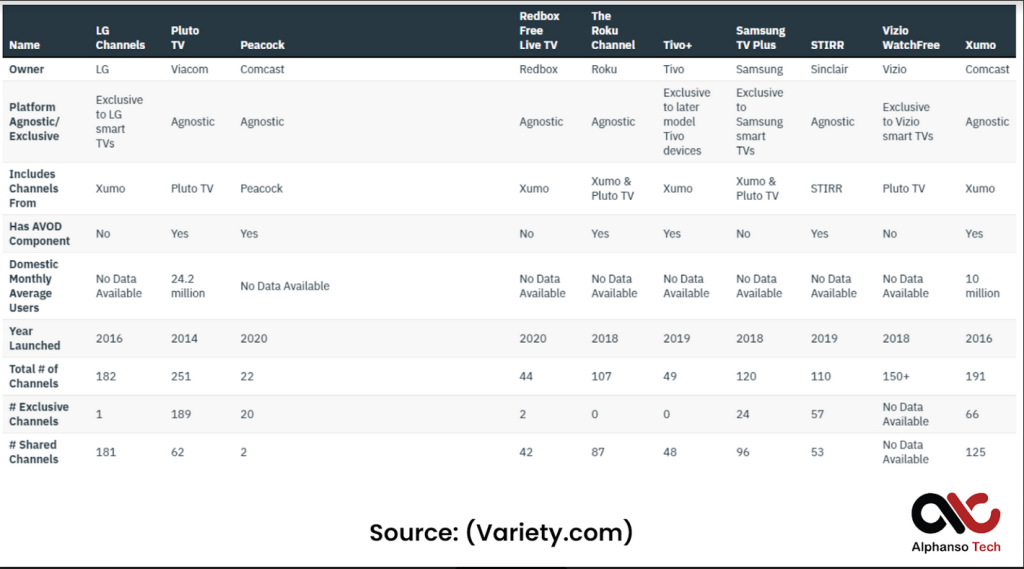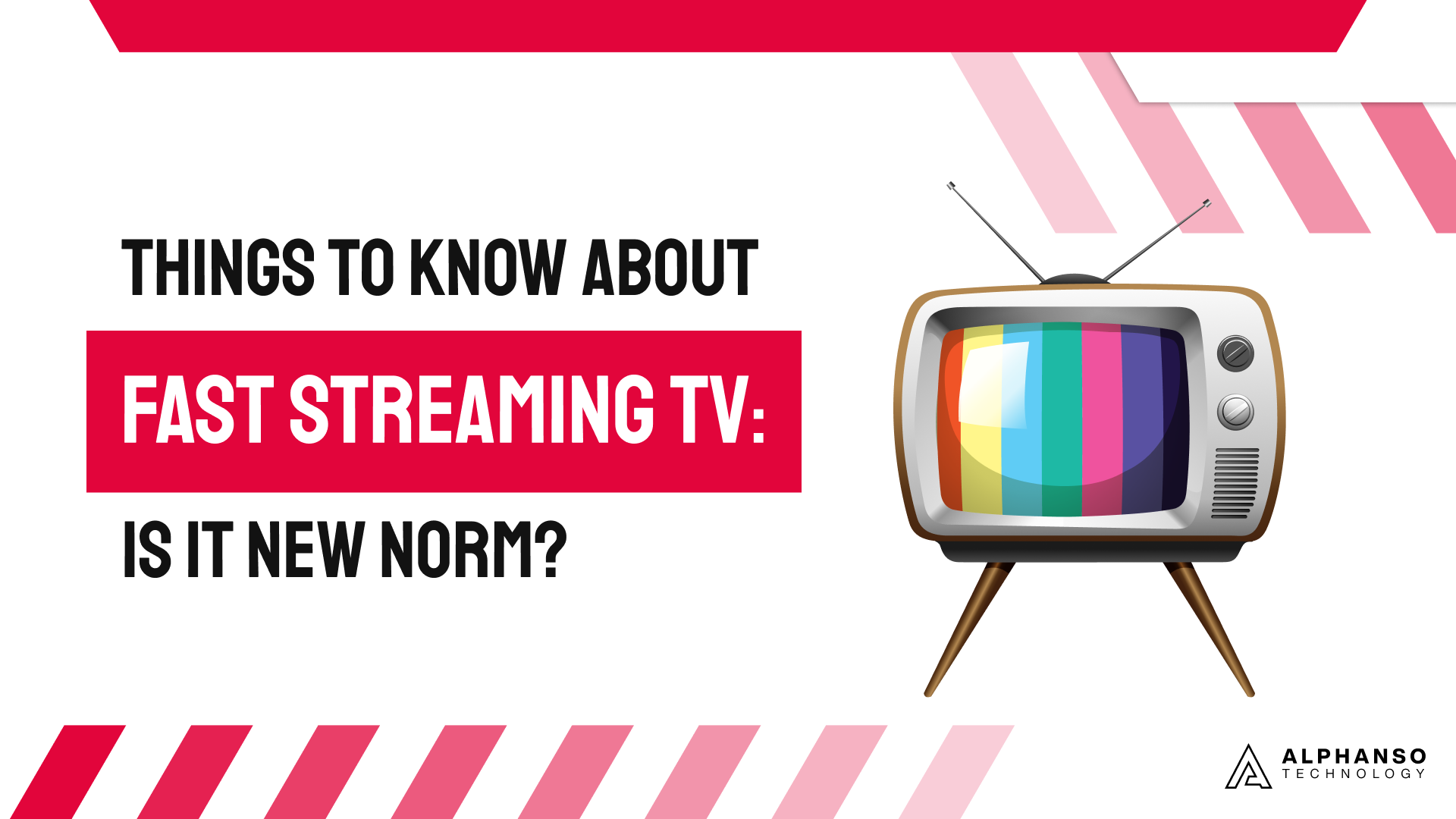When we talk about FAST streaming TV movies and shows, the top players that pop up in your mind include Amazon Prime, Netflix, HBO Max, and more. However, the world of FAST services is growing steadily but doesn’t get the same attention yet attracts millions of viewers. New services provide great opportunities for streaming businesses looking to amplify their streaming content.
This blog explains things about FAST Streaming and also finds whether it is a new norm to stay in the streaming business industry or not.
What is FAST?
Also termed as Free Ad-supported streaming television. It’s a mashup of old and new-style TV viewing. FAST Streaming services enable users to sign up and sign in to watch TV in the same way they are watching cable TV. Shows are aired just like cable on time with ad breaks. If individuals want to upgrade, they can pay a monthly fee. They can enjoy an on-demand experience just similar to apps like Netflix and Hulu.
The FAST world of services includes top players like Samsung TV Plus (with more than 190 channels), Tubi (owned by Fox Corp. with channels like Bloomberg Television, PeopleTV, and Fox Sports, with more than 20,000 shows and movies), and Pluto TV (owned by ViacomCBS, with 250 channels).
The FAST audience is comparatively smaller than the premium subscribers. However many FAST channels have bigger audiences in the US compared with satellite TV and cable. More viewers are turning to FAST services after cutting the cord.
FAST Streaming Experience is Improving: Explore How?
FAST has improved in recent years. Since 2019, four new services have been introduced, and big giants like Comcast and ViacomCBS have bought Xumo and Pluto TV. Comcast launched Peacock, which features a FAST element.
The audience is growing: Pluto added around 10 million monthly viewers, with an additional 1 million added in Q1 2020, whereas Xumo grew by 4.5 million monthly users, with services boosts in the earlier stages of the pandemic.

It’s no longer the domain of digital shorts; straight-to-DVD movies and recycled news clips are taking its place. Big brands have a presence on FAST. The viewing experience has come on in leaps and bounds; there are lots of areas where FAST can enhance both the supplier and the audience experience.
Ad experience is dissected into two areas; the first is ad placement. Channel operators set the spot in their content where ad breaks will run. Few assume the streaming TV platforms do this themselves, but this is based on owned-and-operated channels, not everyone on the service.
The main issue here is that some channels have ideas of when this ad break should run, especially when streaming previous TV content that has ad breaks baked in. Instead of utilizing, content is interrupted mid-sentence before hitting present break placement or coming back to run for a minute.
The second ad issue is the breaks themselves. FAST is viewed in a CTV environment, it’s primed for innovations in how these ads are displayed, yet most ads are traditional video only. If the channels have not sold all inventory, they have the option to repeat the ads that have aired, which results in viewers becoming hostile to the brand advertised. They can even show animation and graphics, representing how the show will resume soon. This is sometimes a waste of time for viewers and channels.
The best solution is to show promos for other content on the channel. This is where a FAST channel platform dynamically shortens the ad break on a feed, which can help to improve viewer experiences. Hopefully, innovations in FAST and the streaming areas are going to continue.
Why Do Viewers Love FAST?
The ability to stream ad-supported content for free saves bundles for viewers. Consumer Reports survey shows that 11% of respondents cut ties to their Pay-TV service provider in 2020 and 2021. More than 61% of rising costs and 93% of internet streaming services provided better value for the money.

For example, around 10% of cable-replacement streaming service subscribers like Hulu+ Live TV, YouTube TV, AT&T TV Now (now called DirecTV Stream), Sling TV, and many more respondents will drop them or already have dropped it. Whereas 7% dropped their subscription to streaming platforms like HBO Max, Netflix, Disney+, and others.
Besides turning to streaming services for TV content, many individuals use antennas. In the same survey, almost 22% of members in the survey responded that they use an antenna to get free over-the-air television signals on more of the sets in their homes. Viewers do not mind seeing the ads mixed in with the free programming. Viewers used to sit through almost 18 minutes of ads per hour while paying for cable TV.
FAST TV and FAST technology providers are going to be the future of what we think of as Comcast. Everybody is considering cord-cutting. If viewers are trying to replicate the traditional cable offering, Netflix would be the TV-on-demand and movies, while Galxy would be where you go to channel surf.
Viewers also can see different ads on the FAST services. Most of the advertising looks like what viewers consider traditional TV. However, the streaming industry is evolving and moving forward with FAST services. This makes it easier for them to run things like ads with QR code calls-to-action for real-time graphics for promotions, eCommerce, and more.
Instead of broadcasting the ads being streamed over the air, the data about what viewers watch or respond to ads will be more detailed than what traditional broadcast networks get. In 2021, nScreenMedia stated that the ad revenue earned by virtual linear channels will rise from $2.1 billion to $4.1 billion between 2021 and 2023.

Past were the days when many forecasted linear TV viewing death. However, it’s clear that the format continues to provide better value to viewers; the FAST market has begun a rapid expansion.
FAST services such as Galxy have a path to a bigger future. These service types have a viable business model. Most streaming players these days partner with different kinds of brands to bring different kinds of shows and channels.
Galxy has introduced its model and started going into the channel business. The platform has been in beta for the past year, but launching in a lot of places now and looking to scale it in 2022.
Top Things About FAST You Can’t Miss Paying Attention to!
The US households’ proportion of video streaming services has increased by 88%. As of June 2022, more than 113 million households accessed streaming services. The growth underscored the resiliency of viewers’ demand and streaming despite challenging economic conditions for United States households.
The increase in US streaming is from all streaming tiers. Paid streaming without ads (SVoD) is 1.5%, up points to 82%, while paid ad-supported streaming (AVoD) grew by 1.6%, which points to 26% household penetration. Free ad-supported streaming (FAST) increased by 2.1% points to 22.3%.

However, all three tiers drove the growth of streaming in Q2 2022; the growth of AVoD accelerated by 3% points while FAST slowed by 2% quarter over quarter in the past. But the scenarios are changing with time. Let’s check a few more things about the FAST that you can’t miss paying attention to.
FAST Platforms are Growing
Many FAST platforms are backed by big players. Comcast has Xumo, Paramount has Pluto, Fox has Tubi, and Peacock has also included a FAST service in its offerings. Big player Amazon has IMDBTV, while Roku and Samsung have their own. Most of the streaming players host multiple channels from outside content providers.
Easier for the Audience to Watch
Viewers don’t need any extra hardware to watch the FAST streaming TV channels. If the audience has something to watch Netflix on, they can even watch FAST platforms as well.
Incredible Bargain for Audiences
Cable TV is forecasted to cost US viewers an average of $2,609 a year. Streaming platforms like Netflix, Disney+, and others cost less unless you try to get them all. Compared to that, FAST services cost nothing above what you already pay for the internet.
Easy to Start a Channel
Multiple services, including Wurl, make it easy to upload the video and make the channel available. FAST streaming TV is looking for content, so it’s much more possible to get a deal for carriage than it’s on cable.
FAST is Broadcast to Cable
In the past, the audience had two choices:
1. Free Broadcast
2. Paid Cable
But FAST services provide something more. These services are free with ads. Moreover, you don’t have to choose between cable and antenna to enjoy its content, both stream over the internet.
The FAST services are viewed as a little bit of a novelty; however, the adoption of FAST is going up, and it is going up steadily. Free ad-supported streaming TV is the best way to reach a broader video audience. FAST is a new streaming phenomenon.
Ending Note
FAST Streaming TV (Free Ad-supported streaming television) has emerged as a significant trend in the streaming industry, offering viewers a cable-like experience with on-demand capabilities. Major platforms like Samsung TV Plus, Tubi, and Pluto TV have gained traction, attracting viewers who seek cost-effective alternatives to traditional cable and satellite TV. These platforms are supported by advertising revenue, allowing viewers to access a wide range of content without subscription fees.
FAQs about FAST Streaming TV:
What is FAST Streaming TV?
FAST stands for Free Ad-supported streaming television. It offers a cable TV-like experience where viewers can watch scheduled programming with ad breaks. Users can also opt for a premium ad-free experience for a fee, similar to services like Netflix and Hulu.
How does FAST Streaming TV work?
FAST platforms stream live TV channels and on-demand content over the internet, accessible via smart TVs, streaming devices, and FAST TV apps. They generate revenue through advertising, which interrupts programming at designated ad breaks.
Is FAST Streaming TV the future of streaming?
FAST services are increasingly popular, especially among cord-cutters seeking affordable alternatives to traditional TV. Their growth indicates a shift towards ad-supported streaming models, complementing subscription-based services in the streaming ecosystem.
How can businesses leverage FAST Streaming TV?
Businesses producing video content can benefit from FAST platforms by reaching a broader audience without the barriers of subscription costs. They can explore partnerships with FAST providers to distribute their content and enhance visibility in the competitive streaming market.
How can I start watching FAST Streaming TV?
To start watching FAST Streaming TV, you typically need a compatible device (smart TV, streaming device, or mobile app) and internet access. Many platforms offer apps that can be downloaded for free, allowing instant access to their content libraries.
Can FAST Streaming TV compete with traditional cable TV?
FAST Streaming TV offers a competitive alternative to traditional cable TV by providing a diverse range of content at no cost to viewers.
What is the future outlook for FAST Streaming TV?
The future of FAST Streaming TV looks promising, with continued expansion and innovation expected in content offerings and advertising technologies. As more viewers embrace streaming over traditional TV, FAST services are poised to play a pivotal role in the evolving media landscape.

